Updated: 30 Sept 2002




Updated: 30 Sept 2002
  |
I was struck by the fact that Roswell, allegedly the location of all sorts of flying saucery, had been the place where Goddard conducted his pioneer work 15 years before. Coincidence? Some more subtle link? The real reason is that New Mexico has a lot of open space. It was suitable for Goddard's rocketry, and also for Roswell Army Air Field, where the 509th Bomb Group was based in 1947. The 509th was at the time the only nuclear bomb group in the world.
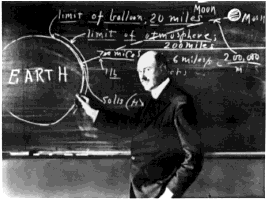
| Robert Goddard is one of the most remarkable figures in the development of space flight. Inspired by Jules Verne and HG Wells, the possibility of interplanetary travel was the mainspring of Goddard's pioneering studies in rocketry. Goddard was not the kind of man to sit around and wait for technologies to be handed down by aliens. He found out for himself how to build the most advanced rockets the world had ever seen.Goddard's rockets may appear at first to have had a very modest performance. His achievments were not so much in height reached or mass lifted, but in developing all the initial technology required to build liquid-fuelled rockets. He introduced liquid fuel, gyroscopic guidance, and steering by vanes in the exhaust stream. |
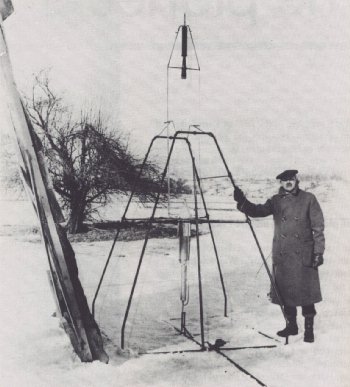
| 16 March 1926. Robert Goddard stands beside the first ever liquid-fueled rocket, at his aunt's farm in Massachusetts.The rocket motor is at the top, and the fuel tanks below, with a conical exhaust shield. This configuration, with the weight at the bottom, is relatively stable without guidance. The length of the rocket was 3.4 metres. Empty weight was 2.6kg, and launch weight was 4.6kg The slanting structure to the left is a windshield. The rocket remained on the launch stand for 20 seconds, until the thrust overcame the dimishing weight of fuel, and then flew for 2.5 seconds, reaching a height of 12.5 metres. It landed 56 metres from the launch point. The estimated thrust of the motor was 40 Newtons. One Newton is roughly the downward gravitational force on an apple; this is (I hope) purely coincidental. |
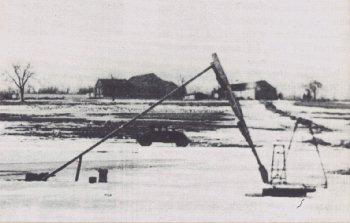
| The Massachusetts site after the launch.Farm buildings in the background. |
CHRONOLOGY.
1902 Submits article on space-flight to Popular Science Monthly. It is rejected.
1908 Graduates from Worcester Polytechnic.
1911 Receives doctorate from Clark University, MA.
1912-13 Studies At Princeton.
1913-1914 Goddard ill with tuberculosis.
1914 Granted patents covering combustion chambers, nozzles, etc. US Patent 1,102,653: Liquid-fuel gun
rocket. US Patent 1103503: A multistage step rocket.
1915 Goddard gives first experimental proof that rockets provide thrust in a vacuum.
1917 Granted $5000 to begin practical work by Smithsonian Institution.
1918 Working on the forerunner of the WW2 bazooka in California. Successfully demonstrated at
the Aberdeen Proving Grounds, Nov 10, 1918.
1920-1923 Part-time consultant on solid-propellant rocket weapons for U.S. Government
at Indian Head, Maryland.
1924 Marries Esther Christine Kisk, his secretary at Clark University.
1925 A liquid-fuel rocket lifts its own weight for the first time in a static test
at Clark University.
1926 Robert Goddard launches the first liquid-fuelled rocket at his aunt Effie's farm
at Auburn, MA.
1929 Reports of Goddard's experiments reach pilot Charles Lindbergh,
and he arranges $50,000 of further funding from the
Daniel Guggenheim Fund.
1930 Goddard moves operations to Mescalero Ranch, near Roswell, NM.
1930-32 First series of launches at Roswell.
1932-34 Laboratory work at Camp Devens, Worcester
1934 Further Guggenheim Funding permits a return to Roswell
for a second series of launches.
1934-40 Second series of launches at Roswell.
1942-1945 Goddard is Director of Research, Navy Dept., Bureau of Aeronautics developing
jet-assisted takeoff & variable-thrust liquid-propellant rockets, at Roswell, NM & Annapolis, MD
1944-1945 Goddard is Director of the American Rocket Society
1945 Goddard dies in Baltimore on 10th August.
Preparations are being made for a static test of a K-series rocket. Judging by the
clothing of those present, the weather was cold.
The simple instrument panel in the foreground seems to consist mostly of pressure
gauges, though the two lower dials are electrical meters. The function of of the
small funnel on top is wholly obscure, to me at least.
A thrust of 2270 Newton was achieved in February, 1936.
Incidents at Roswell: 1930-32.
Incidents at Roswell: 1934-40.
A blowtorch on
a long rod was used to heat and ignite the gunpowder charge at the top of the rocket motor;
effective ignition was essential to prevent a destructive explosion in the combustion chamber.
This problem (then called a "hard-start") was still being tackled in the Viking sounding-rocket
program from 1947 onwards. (That year again!)
Summary of Roswell Launches.
* ie Rocket cleared the launch tower.
1882 Robert Goddard is born in Worcester, Massachusetts, USA.
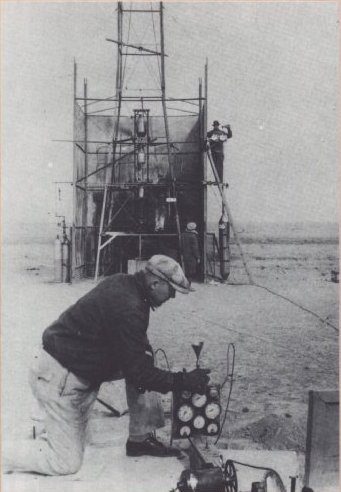
At Roswell
in Nov 1935. In the foreground is Goddard's brother-in-law, Albert Fisk.
Standing in the tower is Nils Ljungquist, the mechanic. On the ladder is Charles Mansur, the welder,
watched by Goddard on the ground.
The machine in the extreme foreground appears to be a motor-driven pump or compressor.The Move to Roswell.
When Goddard received the first $50,000 of funding, it was clear that Massachusetts was too
heavily populated to accomodate the kind of rocket tests now possible. He went West in search of a suitable location, and settled on Mescalero Ranch, near Roswell, NM.
Date
Event
Duration
Max height
30 Dec 1930
First launch of rocket at Roswell
27 Oct 1931
First launch with new petrol valve.
8.6sec
400 metres
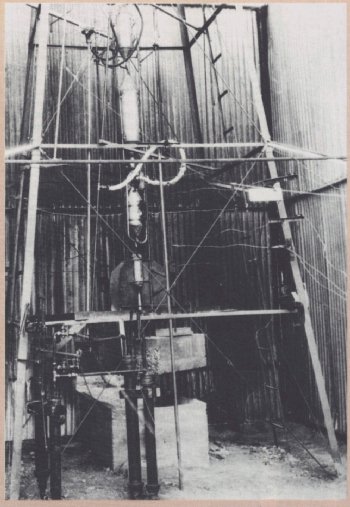
At Roswell, 1930-32.
The rocket is the vertical line of three tanks in the centre; the vertical girders form
the launching frame.
The curved white object appears to be an insulated
hose for filling the liquid oxygen tank.
By the middle of 1932, the Guggenheim funding was exhausted, and Goddard moved
back to his old teaching and research post at Clark University. From 1932 to 1934 Goddard was working on many areas of new technology; materials, gyroscopes, propellant pumps and combustion chambers, aided by a small grant from the Smithsonian Institution.
In 1935 further Guggenheim funding was found and Goddard and his team returned to Roswell for another six and a half
year's work.
Date
Event
Duration
Max height
08 Mar 1935
An A-series rocket exceeds 1130 kph, possibly going supersonic.
28 Mar 1935
An A-series rocket reaches an altitude of 1460 metres.
.
1460m
Nov 1935 - Feb 1936
Static tests
26 Mar 1937
The L13 rocket reaches an altitude of 2.4-2.7 km
.
2700m
20 April 1938
Rocket carrying barograph reaches 1260 metres.
25.3 sec
1260m
Nov 1938 - Aug 1941
Static tests on rockets with turbopumps
09 Aug 1940
First flight of turbopumps
. 90m
8 May 1941
Second flight of turbopumps
.
75m
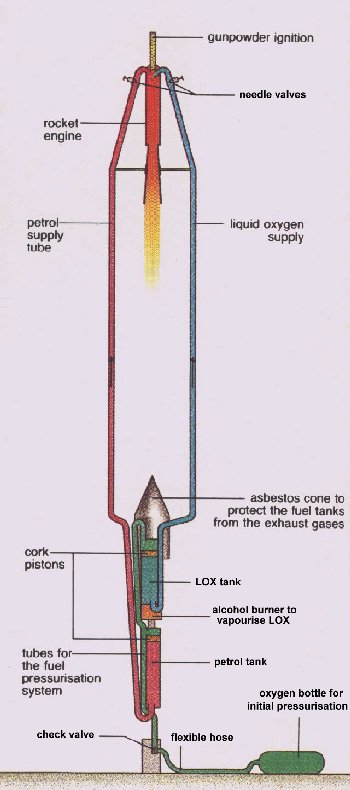
Construction and operation of the first liquid-fuel rocket.
Petrol and liquid oxygen are forced out of their tanks by the pressure of gaseous oxygen from the
external bottle, the cork pistons moving down the tanks as the contents are used. Just before launch, the oxygen bottle was
disconnected, the check valve maintaining the gas pressure in the rocket.
Goddard's researches at Roswell ended in 1941. The advent of the Second World War saw him working on research contracts for the Navy Bureau of Aeronautics and the Army Air Corps, culminating in the production of a variable-thrust rocket motor. Variable thrust (or throttleable engines, to use a more common term) are essential for serious rocket work. Without throttling during launch a rocket would exceed aerodynamically safe speeds while still in relatively thick atmosphere.
Static tests
Flight tests
Flight successes*
First series
21
8
5
Series-A rockets
1
14
>7
Series-K rockets
10
0
0
Series-L rockets
13
17
17
Fuel pump tests
24+
0
0
Gas generator tests
19
0
0
Turbopump tests
15
9
2
GODDARD LINKS.
Aeronautics Learning Laboratory.
The Life of Robert Goddard.
NASA
Robert Goddard and His Rockets.
ARMY
Clark University, Mass.
Roswell Visitor Bureau
They are very proud of Robert Goddard in Roswell.
NASA FROCKET
Liquid-fuelled rockets.
NASA Goddard
More on Goddard.


